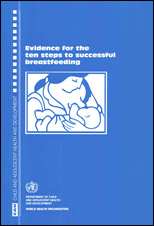 |
|
Evidence for the Ten Steps to Successful Breastfeeding
 Authors: World Health Organization Authors: World Health OrganizationNumber of pages: 111 Publication date: 1998 Languages: English, French, Spanish ISBN: 9241591544 WHO reference number: WHO/CHD/98.9 English [pdf 921kb] French [pdf 640kb] Spanish [pdf 436kb] Overview This review summarizes studies related to each of the Ten Steps to Successful Breastfeeding and studies combining steps. As far as possible the authors included only experimental and quasi-experimental studies. The purpose of the document was to review the evidence for the efficacy of the "Ten Steps" and to provide a tool for advocacy and education. The evidence for most of the Ten Steps to Successful Breastfeeding is substantial, even when each step is considered separately, and despite the inherent difficulties of randomization, when a mother's freedom of choice must be respected. The most clearly established are the three steps concerning guidance and support for the mother. These are: Step 3, antenatal education; Step 5, showing mothers how to breastfeed; and Step 10, continuing support after discharge from hospital. They are the steps which can be the most difficult to implement adequately, and they are often the slowest to be introduced. They require skill, which needs training, and they take health worker time so they require revision of job descriptions. However, together they are among the most cost-effective of all health interventions, and efforts to include adequate support for breastfeeding mothers should be strengthened regardless of limitations of resources. There is good evidence in principle for Step 4, which relates to early contact, though the optimal timing of a newborn's first breastfeed is probably not as restricted as the original wording of the step suggests. The most important part of the procedure is for the baby to have skin-to-skin contact with the mother from immediately after delivery until he or she spontaneously shows readiness to feed. This usually occurs within an hour of birth, though it may be at any time in the first two hours, or later if the mother received pethidine. The evidence for Steps 7, rooming-in, and Step 8, demand feeding, which are easy to implement but difficult to separate from one another, is highly suggestive. There is no evidence supporting the contrary practices of scheduled feeding and nursery care. Demand feeding does not increase the risk of sore nipples; and rooming-in does not necessarily interfere with the mother's rest, and does not increase cross-infection. Step 6, on the use of supplements, and Step 9, on the use of artificial teats and pacifiers, are also closely related. While many studies show a strong association between the use of supplements and artificial teats or pacifiers with premature cessation of breastfeeding, it is not easy to demonstrate a causal relationship, largely because of the difficulty of true randomization. However, if the use of supplements, teats and pacifiers are partly markers of mothers who have difficulties breastfeeding, or who lack confidence, then they are also an indication that health workers need more knowledge and skills to help mothers more effectively. Without adequate guidance and continuing support, the need to use supplements may not be overcome. It remains probable that artificial feeds, teats and pacifiers do interfere physiologically with breastfeeding, and that its ready availability and use undermines a mother's confidence. Pacifiers and teats should rarely be needed in maternity facilities, and there is ample justification for not allowing infants to be given supplements except when there is an unavoidable medical reason, and for giving them when needed by cup rather than bottle. Some evidence suggests that when there is a clear medical indication, supplements may interfere with establishing breastfeeding less than when they are given without such an indication. Two other points are clear in this connection. First, the provision of commercial discharge packs which contain samples of breastmilk substitutes adversely affects breastfeeding, and there is no justification for giving them. Second, discontinuing the provision of formula in maternity facilities has been shown to be one of the most cost-effective health interventions known. There remain Steps 1 and 2, on policy and training, which are necessary for the implementation of all the others. Experience shows that without both strong policies and relevant training of staff, it is not possible to change practices. With the advent of the Baby Friendly Hospital Initiative, a great deal of experience with different kinds of training has been gained. Although they can all have some effect, certain principles are apparent. Eighteen hours of training seems to be an absolute minimum, and a longer time is probably needed for effective increase in skills and change in attitude. Training needs to include a strong practical and clinical component, and not to be predominantly theoretical or classroom-based. Well organized clinical practice seems to change attitudes towards breastfeeding in a way that lectures do not. In conclusion, the basic premise of the Baby Friendly Hospital Initiative, which requires all maternity facilities to implement the Ten Steps to Successful Breastfeeding, is valid. However, selective implementation of only some steps may be ineffective and discouraging. Exclusive breastfeeding will be most effectively increased and sustained when agreed policies and adequate practical training of staff are directed at implementing all the ten steps together, including continuing support for mothers in the community, and restriction of the availability of formula to situations in which there are clearly defined medical reasons. Recommendations
21 February, 2016 |